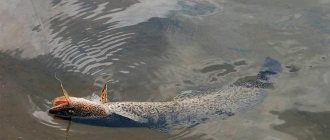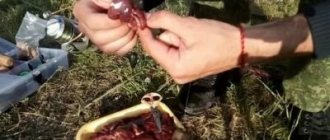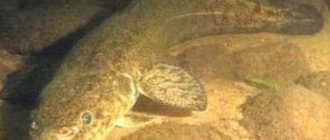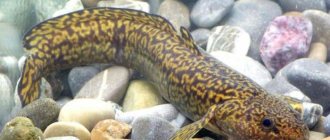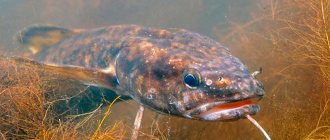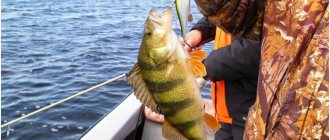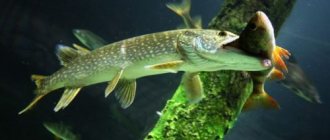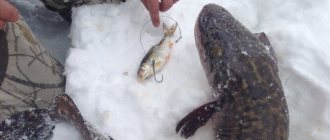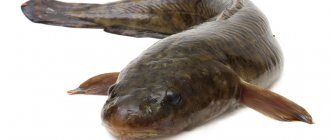Peculiarities of burbot behavior in spring
Content
The behavior of burbot is very different from the behavior of other inhabitants of our freshwater bodies. Burbot is a lover of cold water, and while other fish’s activity increases as the weather gets warmer, burbot’s activity decreases. The most favorable temperature regime for it is up to 10 ᵒC, and when the water warms up to 12-14 ᵒC, the burbot stops feeding.
Spawning of burbot occurs under the ice in December-February, depending on the reservoir, on a frosty night.
The fishing season for this fish lasts from the first frost until the end of the flood, with a break for spawning. They catch him from late evening to early morning. The best bite for burbot occurs on moonless nights in bad weather, and the worse the weather, the more active the burbot. Let's look at how to catch burbot in the spring.
Immediately after the ice melts, spring fishing for this representative of cod begins.
Tackle and methods of catching burbot in spring
Spring fishing for this representative of cod begins immediately after the ice melts and continues until the middle or end of April.
After all, it feeds at the bottom, so it is usually caught with various types of bottom gear:
- snack;
- donka based on spinning tackle;
- feeder or picker.
Near steep shores, a tackle for burbot like a zherlitsa works well. Structurally, it is no different from pike, but is installed in such a way that the sinker lies on the bottom, and live bait or other bait does not rise higher than 15-20 cm.
In commercial fishing they use a burbot line, but in amateur fishing such gear is prohibited. If you want to use multi-hook tackle, you can fish with an elastic band - a donk with a rubber shock absorber. An elastic band installed perpendicularly or at an angle to the shore will cover several fishing horizons, and the presence of several hooks will allow you to use different baits to find out the current preferences of the burbot.
Read more
How to catch an eel?
Over the past few years, jig fishing has become increasingly popular. A small vibrating tail and twister are carried out slowly, with frequent dragging along the bottom. It is better to use “edible” rubber, but the color of the bait is completely unimportant.
Jig fishing has become increasingly popular over the past few years.
Of all the listed methods, catching burbot in the spring with a donk is the main one. Unlike chub, asp and even perch, burbot is indifferent to coarse gear - a main line of 0.4-0.6 and a leash of 0.2-0.4 mm are quite suitable, which simplifies the manipulation of gear during night fishing. The low cost and compactness of the gear allows you to place it in the evening and check it in the morning.
Catching burbot in the spring on a feeder is most often a continuation of daytime fishing for white fish - roach, blue bream, bream. When fishing for burbot, the feeder equipment should be replaced.
It is recommended to use the following gear for catching burbot in the spring:
- a feeder or sinker weighing 40-100 g, depending on fishing conditions;
- combined leash - monofilament line 0.20-0.25 mm in combination with a soft metal leash with a total length of up to half a meter;
- The hooks are large and have a straight long shank. Baitholder-type hooks with additional serrations on the shank are particularly effective.
Fishing tactics
We have to fish in the dark (by the way, I recommend reading a separate article about night fishing), but it is better to arrive at the place early, around lunchtime, so that there is more time left before sunset. We will really need it - for preparing firewood and for catching live bait (by the way, for this you should buy bloodworms, worms or maggots before fishing).
For the main fishing point, it is best to choose a place where the pebble or sandy shore gradually goes into the depths. There you can put a couple of feeders or donks from a spinning rod, and at the same time make a fire. It will not only warm the fisherman, but also illuminate the water area. Small fish will definitely swim into the light of the fire at night, and burbot will come after them. However, it is believed that he himself is also attracted to light.
At some distance from the fire - to the right and to the left, trinkets are placed, about 20 meters apart each. The quantity depends on the skill and conscience of the fisherman (as you know, the number of hooks per catcher, according to the Fishing Rules, is limited). It is better to equip them with ringing bells - which could be heard from afar. And it’s very good if each bell “plays” its own note - this way you can roughly determine by ear which trick worked.
In principle, you can cast anywhere where the depth is not very great and the bottom is more or less hard, corresponding to the preferences of burbot. However, you should avoid flooded bushes and meadows. Burbot does not like grass - “land grass” and last year’s grass. And in the bushes, caught fish can easily get entangled, which will lead to the loss of gear and trophy.
It is clear that the choice of places and the preparation of pegs for throws should also be carried out long before dusk. It’s also better to throw the gear around the world - just before sunset.
But then night comes. Cold. Quiet. Only the logs crackle, and occasionally a woodcock wheezes and wheezes in the air. The craving is just beginning. Sitting around the fire at this time - with a hot mug of tea - brings special satisfaction to the soul. This is the first trip to the river - after the winter break.
Only this silence lasts for a long time. Maybe today is not a burbot night? The sky is moonless, full of stars. Suddenly something to the side clinked twice. Shh! After a pause, the bell rings again. Eat!
In the light of the lantern, the fishing line of one of the “pokes” beats. After a “control hook” and some fishing, a dark olive fish with a marble pattern appears on the shore, bent into a ring. Here is the first burbot! We didn’t have time to swallow the bait deeply, which means we don’t change the leash (we have fifty of them in stock). But the nozzle should be replaced - the gudgeon is pretty dented.
And at the most inconvenient moment, you suddenly hear the squeak of the signaling device on the donk from the spinning rod!
That is why it is better to go with a partner when fishing for burbot in the spring.
Yes, it’s also advisable to take a landing net - not so much for a possible monster, but to make it easier to get fish out of the water. Burbot is very slimy, catching it with your hands is another “pleasure”, especially when it’s cold.
This is interesting: Burbot fishing in May
Where to fish for burbot in spring?
Burbot inhabits most rivers and some spring-fed lakes. It adheres to a coastal zone with moderate currents and a hard bottom. Where to catch burbot on the river in spring? It is best to look for burbot along steep banks in places with reverse currents. It’s good if there are rubble of stones nearby, as well as snags in which he hides during the day. A sign of the presence of burbot can be the absence of catfish in the fishing area, with which burbot does not get along.
It is best to look for burbot along steep banks
Description of burbot
To remember this fish, we suggest looking at the photograph, and it already becomes clear that burbot is a bottom dweller. It prefers to stay among snags, stones, in holes, feeds mainly at night, often runs aground, and combs the shores. As mentioned above, the colder the better. Hence the simple conclusion: in colder regions and waters, optimal conditions for development are created for burbot, therefore, there it reaches more impressive sizes. In the rivers of the Nizhny Novgorod region, Vladimir and Moscow regions, for example, most often you come across burbot of the order of 500-2000 grams, but this does not mean at all that there are no “trophies” here either. There is, it’s just not so easy to take it, find it, and endurance is required, since on an ordinary sunny and warm day, the burbot simply does not bite, and in the cold and cold, not every fishermen will decide to go fishing, besides , Overnight.
The body of the burbot (the upper part is darker, the lower white-yellow) is elongated, the surface is covered with mucus, it is very difficult to hold this fish in your hands without special gloves. Almost impossible, it slips out. Externally, its body resembles a spindle, a tube, the body of a catfish, with which the large burbot has some similarities.
When is burbot caught in the spring?
When talking about fishing in spring, one should distinguish between calendar spring and actual spring. So, depending on the weather, you can catch burbot in open water in February, as well as from ice in mid-March. The most effective gear for ice fishing for burbot is a girder and a snooker. How to catch burbot using a snooker in March? If there is ice on the reservoir, you need to make a hole and tap the tackle on the bottom, making characteristic sounds that attract burbot.
Fishing for burbot in early spring begins as soon as the ice melts. In fact, from now on you can catch burbot in thawed areas.
The question of how to catch burbot in the spring in March and April is quite broad. Therefore, we will separately consider which baits are best suited for such fishing, as well as the main tactical features of using the appropriate gear.
Read more
What to feed crucian carp in spring?
Burbot fishing in March
Burbot is a nocturnal predator, so the most active biting is observed at night. Burbot loves cold water, so March is the most favorable spring month for catching it. The best bite starts around 4 a.m. and lasts about two hours.
Fishing for burbot requires time spent in advance. After all, it is necessary not only to find out the area in which the fishing will be carried out, but also to obtain bait. It is best to use small fish as bait, which the predator loves. Small specimens of roach and crucian carp are ideal.
The most suitable gear for fishing would be a donka with a long rod. The fishing line must be thick, capable of withstanding powerful jerks of large fish. You can take double hooks for convenient attachment of live fish. The sinker must be powerful, it must withstand abandoned tackle in a certain place. Donka can be cast directly from the shore, because in early spring there is still no lush vegetation on the shore. It is necessary to attach a bell to the donk, which will help the fisherman navigate at night.
Read: Feeding burbot
Tips and lures for spring fishing for burbot
Burbot is primarily a predator, and only secondarily a scavenger, and therefore, the best for catching it are live, moving baits. However, burbot responds almost as readily to non-living baits.
Let’s decide what’s best for catching burbot in the spring:
The best and most versatile attachment for burbot live bait
- Live bait is the best and most versatile bait for all predatory fish. The best live bait for burbot are ruffes, minnows and gobies, but any fish of the appropriate size will do.
- The worm is the second most effective bait for burbot; in the spring it often works better than live bait.
- Dead fish is a classic burbot bait; you can really use both dead live bait and frozen fish specially prepared for this purpose. Of course, frozen fish is thawed before use.
- “Cutting” fish – fish too large to be used is cut whole into pieces of the required size.
- Bird entrails are an effective bait that attracts burbot well with its scent. The entrails, cut into small pieces, can be used as bait. Separately, it is worth mentioning chicken (and other poultry) liver - it is an effective bait for many types of fish, but due to its tenderness it is used especially in active fishing, because it can be knocked off the hook by the fish.
- Shellfish meat is a good bait if there are large bivalve mollusks in the reservoir. The disadvantage is the difficulty of storage. Most often they are mined directly from the reservoir before use.
- Frog - a bait often mentioned in the literature during the spring fishing period, is not readily available, and does not work in all reservoirs. It makes sense to use a frog (namely a frog, not a toad) only if other baits are unavailable.
When choosing a bait for burbot, it is worth considering that the common opinion about the attractiveness of spoiled, “smelly” baits is erroneous. In fact, fresh, or better yet live baits are more effective.
Features of spring fishing
Fishing for burbot takes place in conditions of raised water, and therefore the most suitable places that the fish choose should be looked at in the summer and autumn periods. These can be whirlpools, deep areas without a current, cliffs of relatively shallow depth, stone ridges near holes, certain places on the beaches, and also where the river flows into another body of water and there are underwater springs.
Active movement of burbot is observed along the summer coastline, which is located in the flood zone. Therefore, the bait should be placed on this line or a little deeper. It should also be taken into account that the fish may come closer than usual. But the most unpromising activity is fishing in areas with thick last year’s grass and in flooded meadows. Burbot is too scrupulous in choosing habitat areas and does not exist in such places.
Photo 1. At the river bend.
How and what is the best way to catch burbot in the spring?
Of all the gear, the most productive are the hooks. Let's talk about how to properly catch burbot in the spring using a donk. Catching burbot with hooks in the spring is not particularly sporty, but it can be interesting and exciting. Bottom equipment for catching burbot in the spring is simple, one might even say primitive, but, nevertheless, it must be done correctly.
Zakidushki are the most productive of all tackles
Of the two types of bottom rigs used: in-line and paternoster, the first should be chosen for active fishing, when the fisherman monitors the gear and reacts to the bite, and the second - for passive fishing, in which the gear placed in the evening is checked in the morning.
The second productive way is to catch burbot in the spring using girders. They are used in places where there is no need to throw the tackle, but simply lower it vertically down. The advantage of the girders in the supply of fishing line that the fish can reel in is at the same time their disadvantage, since the girders can only be used in places where there are no snags and underwater boulders; hiding there, the burbot will tangle the fishing line. When fishing with girders, you need to make sure that the bait lies on the bottom or does not rise above 10-20 cm from it.
Read more
What does it consist of and how to make bait for roach?
All other methods of fishing - feeder, spinning, etc., being sports, are more interesting, especially for adherents of these methods, but are inferior in effectiveness to ordinary donks.

